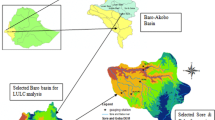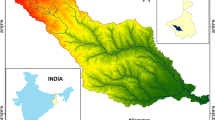Abstract
Since 70’s land changes have been the main driving force inducing environmental degradation in Brazil, particularly in São Paulo State. Considering its very close relationship with landscape evolution, land change pattern and landform classification were analyzed to understand soil degradation in Clarinho watershed (40.89 km2) and propose specific management measures for recovering and conservation. Land change analysis was assessed using LCM toolbox. Landform evaluation was based on Brazilian approach for terrain evaluation. Results show that temporary and permanent soil exposures, due to extensive livestock in naturally fragile areas (i.e. more erodible soils in major surface runoff taxes), are the main triggers in soil degradation. Terrain evaluation also indicates highly fragile landforms due to its relief characteristics and morphogenetic processes. Thick soil profiles which are developed from medium grained rocks, in wide convex slopes, describe the main landforms attributes in inducing degradation. Areas subject to land changes are those in which susceptibility to erosion is high and where records of erosion processes were more expressive. Clarinho watershed large areas need to be treated as “zone for conditioned farming use”, with specific management directives and measures.
Access provided by Autonomous University of Puebla. Download conference paper PDF
Similar content being viewed by others
Keywords
1 Introduction
In the southeast region of Brazil, the expansion of farming has been the main trigger of soil degradation, particularly erosion, since the early 1960s. Accelerated erosion processes have resulted in large environmental changes in the natural environmental dynamics (He et al. 2006), resulting in serious urban problems (Gupta and Ahmad 1996) and causing serious food production problems (Pimentel 2006).
The northeastern region of São Paulo State, where the studied area is located, presents the highest indicators of potential natural erosion among those identified in Brazil (Silva et al. 2011). The intensification of environmental studies resulted in new legislation focusing on the reduction of rural and urban erosion. Despite these legislations, the adoption of such measures requires proper technical knowledge on the environment to be effective (Bocco et al. 2011).
In the Clarinho River watershed, such studies have not previously been undertaken, resulting in intense erosion processes. Despite the influences of soils and relief on the onset of erosion processes, human activities also caused erosion processes and their intensification (Lorandi and Lollo 2015).
To evaluate the relationship between land use dynamics and erosion in the Clarinho River watershed, this work, which was financially supported by FAPESP (Project 2013/03699-5) and the CAPES and CNPq scholarships, was carried out.
The characterization of land change in the area was conducted using the Land Change Modeler (LCM) module from Idrisi™ Selva (Clark 2012), and the analysis of erosion susceptibility was developed using ArcGis® 10.2 (Esri 2011).
The LCM module was developed to analyze land change, considering the contributions of each land use class on the conversion of other classes (Eastman 2012). The LCM module has been widely used for watershed analyses (Piroli et al. 2011, 2012) and the prediction of future scenarios (Oñate-Valdivieso and Sendra 2010; Huong and Pathirana 2013).
2 Studied Area
The Clarinho River watershed is located in the northeastern region of São Paulo State, Brazil (Fig. 1).
The Clarinho River watershed has an area of 40.89 km2 with a population of 26,410 inhabitants. Its original vegetation consisted of forests and savannahs, which have been replaced by agricultural activities, mainly sugar cane cultivation, and livestock.
The area is located in the Paraná sedimentary basin, with a peripheral depression morpho-sculpture, which developed in Paleozoic and Mesozoic sedimentary rocks (São Paulo—FFLCH/USP-IPT-FAPESP 1997). The local relief comprises hills with tabular large tops, shallows valleys, and wide interfluves. The prevalent altitude varies from 500 to 650 m, and the steepness varies between 5 and 10% (Guerrero 2014).
The climate of the area is humid tropical with a dry winter (May–September) and intense rainfall in the summer (October–April), with rains concentrated in the months of December, January and February (Mendonça and Danni-Oliveira 2007).
The geological units (São Paulo-IG 1981—Fig. 2) are: sandy alluvial deposits with clay and gravel lenses (Q); the Santa Rita Formation—SrpT (sandstones with clay matrix and gravel layers at the base); the Serra Geral Formation—JKsg (tholeiitic basalts with sandy lenses associated with sills and dicks); the Botucatu Formation—JKb (fine to medium sandstones, conglomeratic base); and the Pirambóia Formation—JKp (very fine to medium sandstones with intercalated siltite and argillite).
3 Data Survey and Treatment
The main geotechnical properties of the soil units in the area were assessed using the Brazilian standards NBR 6508 (ABNT 1984a), NBR 7181 (ABNT 1984b), ME 258 (DNER 1994). The basic soil characterization included the determination of grain density, particles size distribution, and Mini-MCV compaction with MCT classification.
Using the terrain evaluation technique, we recognized two land systems in the Clarinho River watershed. In these land systems, five land units were identified, i.e., two in System A and three in System B.
The land use/cover classification was performed with Landsat 5 and 8 images obtained on 03/06/1995 and 17/08/2005 (TM Sensor—Landsat 5) and 09/12/2015 (OLI Sensor—Landsat 8) via a supervised classification technique using the R5G4B3 (Landsat 5) and R6G5B4 (Landsat 8) compositions and the following adopted classes: forest, pasture, exposed soil, and agriculture.
By using the land use/cover classification results for the years 1995, 2005 and 2015, the LCM module from Idrisi was used to determine the land changes and transitions between classes.
The map of erosion susceptibility was produced according to Lollo and Senna (2012), combining steepness, landforms, soils and land use/land cover. The weight values associated with the susceptibility to soil erosion were 1 for low susceptibility, 2 for intermediate susceptibility, and 3 for high susceptibility. The algebra map was executed in ArcGis® 10.2 (Esri 2011), and the weights are shown in Table 1.
4 Results and Discussion
Based on the field surveys, field sampling, and laboratory soil tests (results in Table 2), the soil unit map was produced. The land units identified in the area (described in Table 3) are represented in the land unit chart. The rock unit map, steepness chart, soil map, and land unit chart are shown in Fig. 3.
The map algebra developed according to the principles in Table 1 resulted in the soil erosion susceptibility chart presented in Fig. 4. The chart also presents the erosive processes recorded in the watershed (IPT 2012).
The results show that the natural environmental components resulting in a high susceptibility to soil erosion were sandy thick soil profiles associated with convex slopes, mainly in areas with high steepness values. Despite this, significant part (37.5%) of recorded erosion processes were not related to an association with these natural conditions, suggesting that other factors (i.e., land use/land cover dynamics) had a relevant influence in the erosion occurring in the area.
The land use/cover classifications for the years 1995, 2005, and 2015 are presented in Fig. 5. The classification considers the land use/cover classes forest, pasture, exposed soil, and agriculture.
The main land changes in 1995–2005 were forest area reductions and increases in pasture class areas. These changes, associated with exposed soil persistence areas, indicate an increase in the soil erosion potential.
During 2005–2015, continuing reduction in forest areas and related pasture areas increases were observed. Pasture increases are also related to exposed soil reduction. Table 4 illustrated these land changes.
Results show that the most significant land changes for 1995–2005 and 2005–2015 were transitions from forest to pasture and, secondarily, transitions from agriculture to exposed soil. During 2005–2015, we also noted the transition of agriculture areas to pasture areas.
When the relationships between high erosion susceptibility areas according to Guerrero (2014), land changes, and erosion process records in the area were considered, it was verified that the expressive areas occupied by pasture and exposed soil coincided with areas with a high susceptibility to erosion and a high concentration of erosion process records.
Regarding the areas that transitioned from forest to agriculture, such effects are less significant, probably due to soil management and conservation practices adopted for sugarcane cultivation in recent years, which have reduced the occurrence of erosive processes.
5 Conclusions
The Clarinho River watershed presents natural conditions, especially in terms of soils, that indicate a high susceptibility to erosion processes. However, erosion processes are especially likely to occur in areas where the land use/cover classes are exposed soil and pasture.
The use of the LCM allows us to determine that the major land changes over the past 20 years have been forest removal for agricultural activities and, to a lesser extent, pasture activities. The areas that were more subject to land changes shown several erosion process records, even when its erosion susceptibility were not high.
Thus, special attention should be given to such land changes, accompanied by soil conservation and management practices and other measures to avoid the development of new erosive processes. Forest areas, particularly environmental protection areas, need the proper policing of guidelines related to the restriction of land use, mainly pasture land use.
In agricultural areas, the policies for land use must require proper soil management techniques as a basic condition for cultivation and the expansion of grazing.
References
Bocco, G., Mendoza, M.E., Velázquez, A.: Remote sensing and GIS-based regional geomorphological mapping. Geomorphology 39(1) (2001)
Clark University, Idrisi Selva: Version 17. Worcester, Ma. (2012)
Eastman, J.R.: Idrisi Selva: Tutorial Version 17. Clark University, Worcester, Ma (2012)
ESRI: ArcGis 10.2. Environmental Systems Research Institute. Readlands, Ca. (2011)
Guerrero, J.V.R.: Geo-environmental zoning for Clarinho River Watershed using terrain evaluation, at 1:50.000 Scale. UFSCar, São Carlos. (2014)
Gupta, A., Ahmad, R.: Urban steeplands in tropics: an environment of accelerated erosion. Geo. J. 49, 143–150 (1996)
He, X., Zhou, J., Zhang, X., Tang, K.: Soil erosion response to climatic change and human activity during the quaternary of the Loess Plateau. China. Reg. Environ. Change 6, 62–70 (2006)
Huong, H.T.L., Pathirana, A.: Urbanization and climate change impacts on future urban flooding in Can Tho city, Vietnam. Hydrol. Earth Syst. Sci. 17(1), 379–394 (2013)
IPT. Registration of erosion and flood points in the State of São Paulo. São Paulo (2012)
Lollo, J.A, Senna, J.N.: Establishing susceptibility for soil erosion—distinct techniques for distinct decision support phases. In: Environment Congress Annals, pp. 178–186. AUGM, Buenos Aires (2012)
Lorandi, R., Lollo, J.A.: Geo-environmental analytics cartography Claro River Watershed. UFSCar/FAPESP, São Carlos (2015)
Mendonça, F., Danni-Oliveira, I.M.: Climatology: basis and climates of Brazil. Oficina de Texto, São Paulo (2007)
Oñate-Valdivieso, F., Sendra, J.B.: Application of GIS and remote sensing techniques in generation of land use scenarios for hydrological modeling. J. Hydrol. 23, 256–263 (2010)
Pimentel, D.: Soil erosion: a food and environmental threat. Environ. Dev. Sustain. 8, 119–137 (2006)
Piroli, E.L., Ishikawa, D.T.K., Demarchi, J.C.: Land change analysis in Furnas Stream Watershed, Ourinhos—SP, between 1972 and 2007, and environmental protection areas impacts. In: Remote Sensing Brazilian Symposium Annals, pp. 6333–6340. SBSR, Curitiba (2011)
Piroli, E.L., Perusi, M.C., Zanata, J.M.: Land changes and soil impacts in Da Veada Stream, Ourinhos—SP. Revista Geonorte 1(4), 855–865 (2012)
São Paulo. Geological Institute. Geological Map: Santa Rita do Passa-Quatro (SF-23-V-C-V-1). São Paulo (1981)
São Paulo-FFLCH/USP-IPT-FAPESP. São Paulo State Geomorphological Map. São Paulo (1997)
Silva, A.M., Alves, C.A., Watanabe, C.H.: Natural potential for erosion in Brazilian territory. Soil Eros. Stud. 11(1), 1–22 (2011)
Author information
Authors and Affiliations
Corresponding author
Editor information
Editors and Affiliations
Rights and permissions
Copyright information
© 2019 Springer Nature Switzerland AG
About this paper
Cite this paper
de Lollo, J.A., Guerrero, J.V.R., Abe, A.C.P., Lorandi, R. (2019). Land Change, Soil Degradation Processes, and Landscape Management at the Clarinho River Watershed, Brazil. In: Shakoor, A., Cato, K. (eds) IAEG/AEG Annual Meeting Proceedings, San Francisco, California, 2018 - Volume 2. Springer, Cham. https://doi.org/10.1007/978-3-319-93127-2_15
Download citation
DOI: https://doi.org/10.1007/978-3-319-93127-2_15
Published:
Publisher Name: Springer, Cham
Print ISBN: 978-3-319-93126-5
Online ISBN: 978-3-319-93127-2
eBook Packages: Earth and Environmental ScienceEarth and Environmental Science (R0)









